HLTAAP001: Assessments on Recognising Healthy Body Systems
VerifiedAdded on 2023/06/14
|21
|4085
|53
Homework Assignment
AI Summary
This HLTAAP001 assignment focuses on recognising healthy body systems through a case study and various assessments. It identifies affected body systems in a patient, locates organs and system components, describes the structure and function of various body systems (cardiovascular, respiratory, musculoskeletal, endocrine, digestive, urinary, reproductive, integumentary, lymphatic, nervous, and immune), and explains special senses like vision, hearing, smell, taste, and equilibrium. The assignment also covers hypoglycemia and its first aid, and details the structure of the eye. Desklib offers more solved assignments and study resources for students.
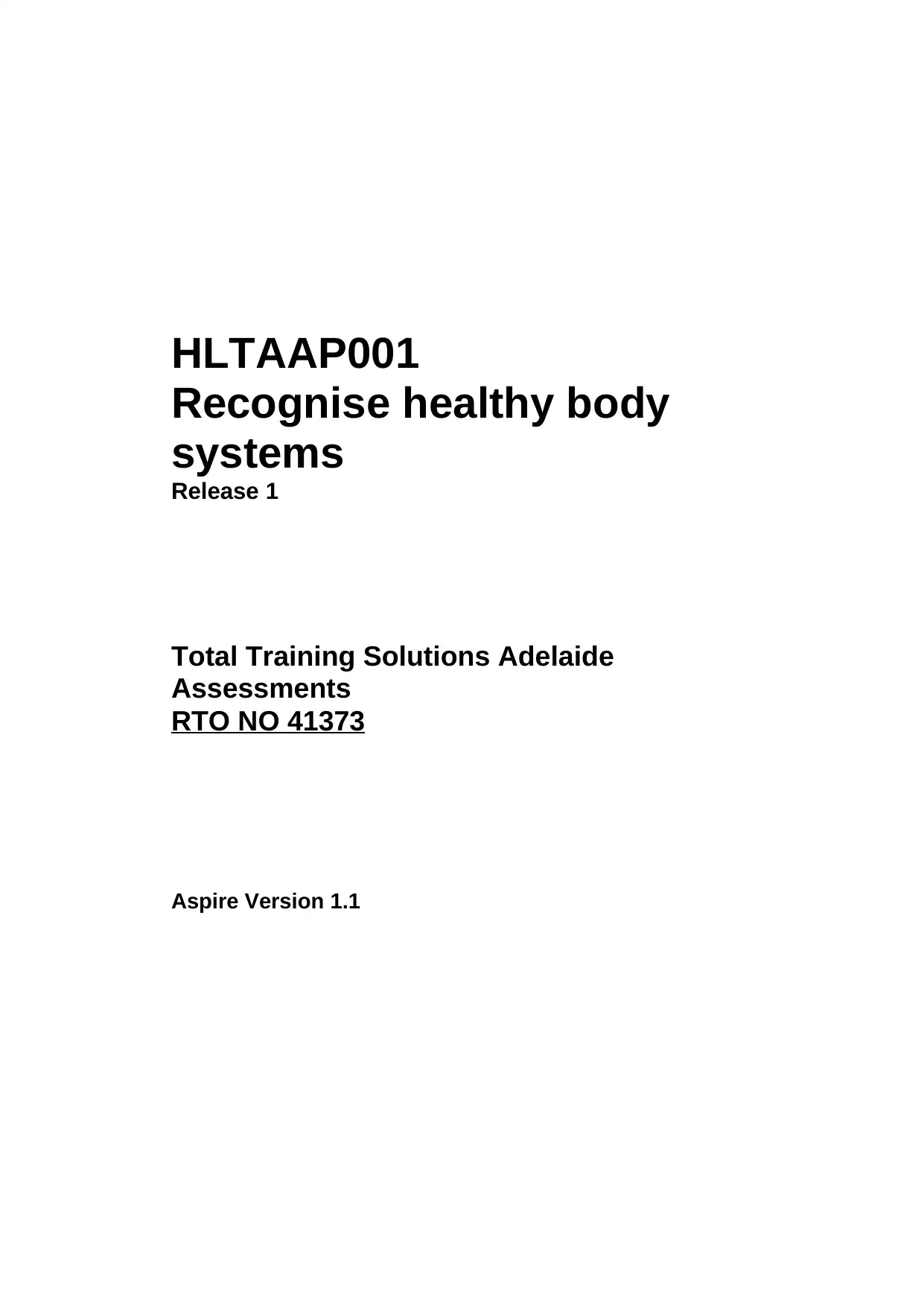
HLTAAP001
Recognise healthy body
systems
Release 1
Total Training Solutions Adelaide
Assessments
RTO NO 41373
Aspire Version 1.1
Recognise healthy body
systems
Release 1
Total Training Solutions Adelaide
Assessments
RTO NO 41373
Aspire Version 1.1
Paraphrase This Document
Need a fresh take? Get an instant paraphrase of this document with our AI Paraphraser
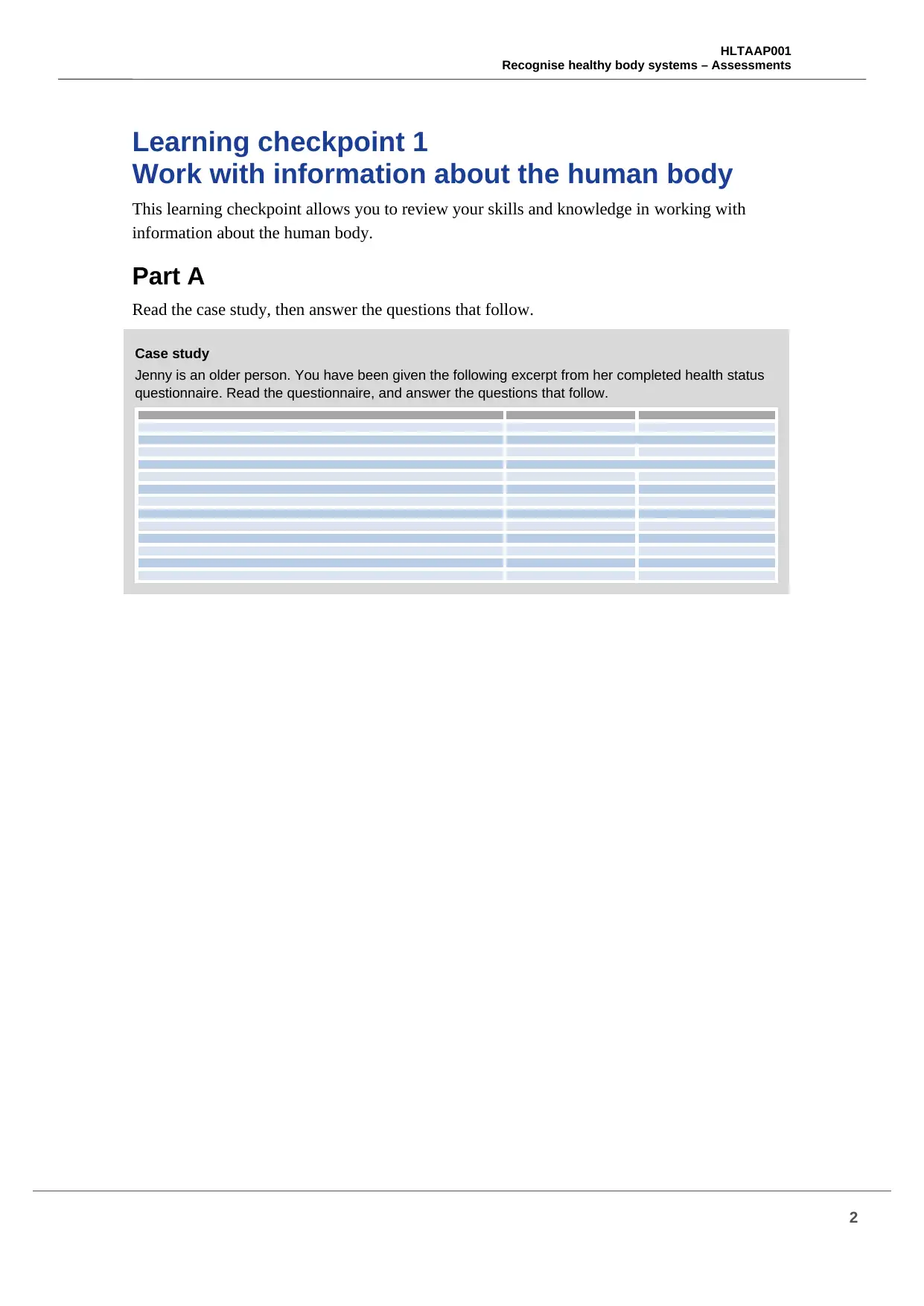
HLTAAP001
Recognise healthy body systems – Assessments
Learning checkpoint 1
Work with information about the human body
This learning checkpoint allows you to review your skills and knowledge in working with
information about the human body.
Part A
Read the case study, then answer the questions that follow.
Case study
Jenny is an older person. You have been given the following excerpt from her completed health status
questionnaire. Read the questionnaire, and answer the questions that follow.
2
Recognise healthy body systems – Assessments
Learning checkpoint 1
Work with information about the human body
This learning checkpoint allows you to review your skills and knowledge in working with
information about the human body.
Part A
Read the case study, then answer the questions that follow.
Case study
Jenny is an older person. You have been given the following excerpt from her completed health status
questionnaire. Read the questionnaire, and answer the questions that follow.
2
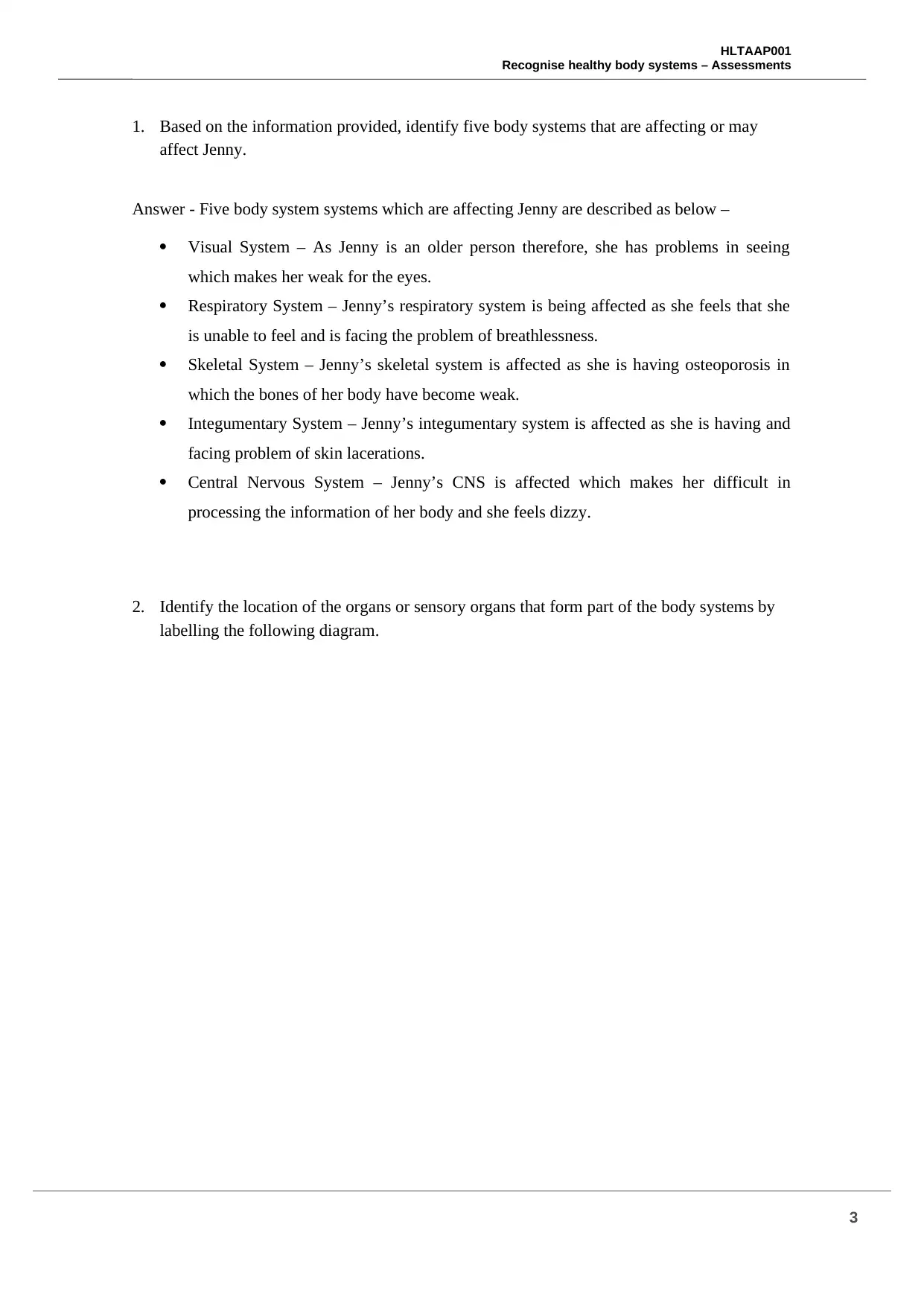
HLTAAP001
Recognise healthy body systems – Assessments
1. Based on the information provided, identify five body systems that are affecting or may
affect Jenny.
Answer - Five body system systems which are affecting Jenny are described as below –
Visual System – As Jenny is an older person therefore, she has problems in seeing
which makes her weak for the eyes.
Respiratory System – Jenny’s respiratory system is being affected as she feels that she
is unable to feel and is facing the problem of breathlessness.
Skeletal System – Jenny’s skeletal system is affected as she is having osteoporosis in
which the bones of her body have become weak.
Integumentary System – Jenny’s integumentary system is affected as she is having and
facing problem of skin lacerations.
Central Nervous System – Jenny’s CNS is affected which makes her difficult in
processing the information of her body and she feels dizzy.
2. Identify the location of the organs or sensory organs that form part of the body systems by
labelling the following diagram.
3
Recognise healthy body systems – Assessments
1. Based on the information provided, identify five body systems that are affecting or may
affect Jenny.
Answer - Five body system systems which are affecting Jenny are described as below –
Visual System – As Jenny is an older person therefore, she has problems in seeing
which makes her weak for the eyes.
Respiratory System – Jenny’s respiratory system is being affected as she feels that she
is unable to feel and is facing the problem of breathlessness.
Skeletal System – Jenny’s skeletal system is affected as she is having osteoporosis in
which the bones of her body have become weak.
Integumentary System – Jenny’s integumentary system is affected as she is having and
facing problem of skin lacerations.
Central Nervous System – Jenny’s CNS is affected which makes her difficult in
processing the information of her body and she feels dizzy.
2. Identify the location of the organs or sensory organs that form part of the body systems by
labelling the following diagram.
3
⊘ This is a preview!⊘
Do you want full access?
Subscribe today to unlock all pages.

Trusted by 1+ million students worldwide
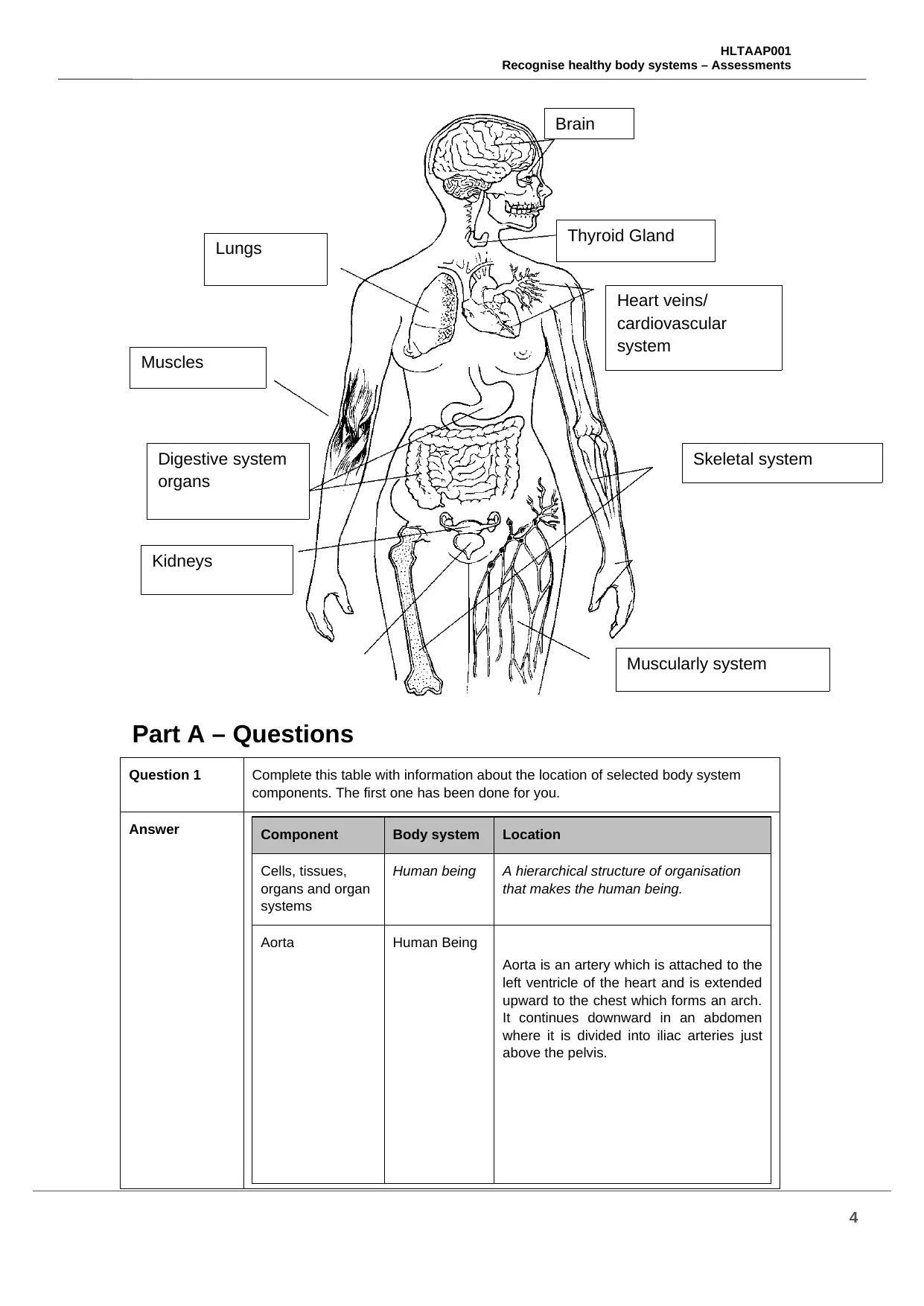
HLTAAP001
Recognise healthy body systems – Assessments
Part A – Questions
Question 1 Complete this table with information about the location of selected body system
components. The first one has been done for you.
Answer Component Body system Location
Cells, tissues,
organs and organ
systems
Human being A hierarchical structure of organisation
that makes the human being.
Aorta Human Being
Aorta is an artery which is attached to the
left ventricle of the heart and is extended
upward to the chest which forms an arch.
It continues downward in an abdomen
where it is divided into iliac arteries just
above the pelvis.
4
Brain
Thyroid Gland
Heart veins/
cardiovascular
system
Lungs
Muscles
Digestive system
organs
Kidneys
Skeletal system
Muscularly system
Recognise healthy body systems – Assessments
Part A – Questions
Question 1 Complete this table with information about the location of selected body system
components. The first one has been done for you.
Answer Component Body system Location
Cells, tissues,
organs and organ
systems
Human being A hierarchical structure of organisation
that makes the human being.
Aorta Human Being
Aorta is an artery which is attached to the
left ventricle of the heart and is extended
upward to the chest which forms an arch.
It continues downward in an abdomen
where it is divided into iliac arteries just
above the pelvis.
4
Brain
Thyroid Gland
Heart veins/
cardiovascular
system
Lungs
Muscles
Digestive system
organs
Kidneys
Skeletal system
Muscularly system
Paraphrase This Document
Need a fresh take? Get an instant paraphrase of this document with our AI Paraphraser
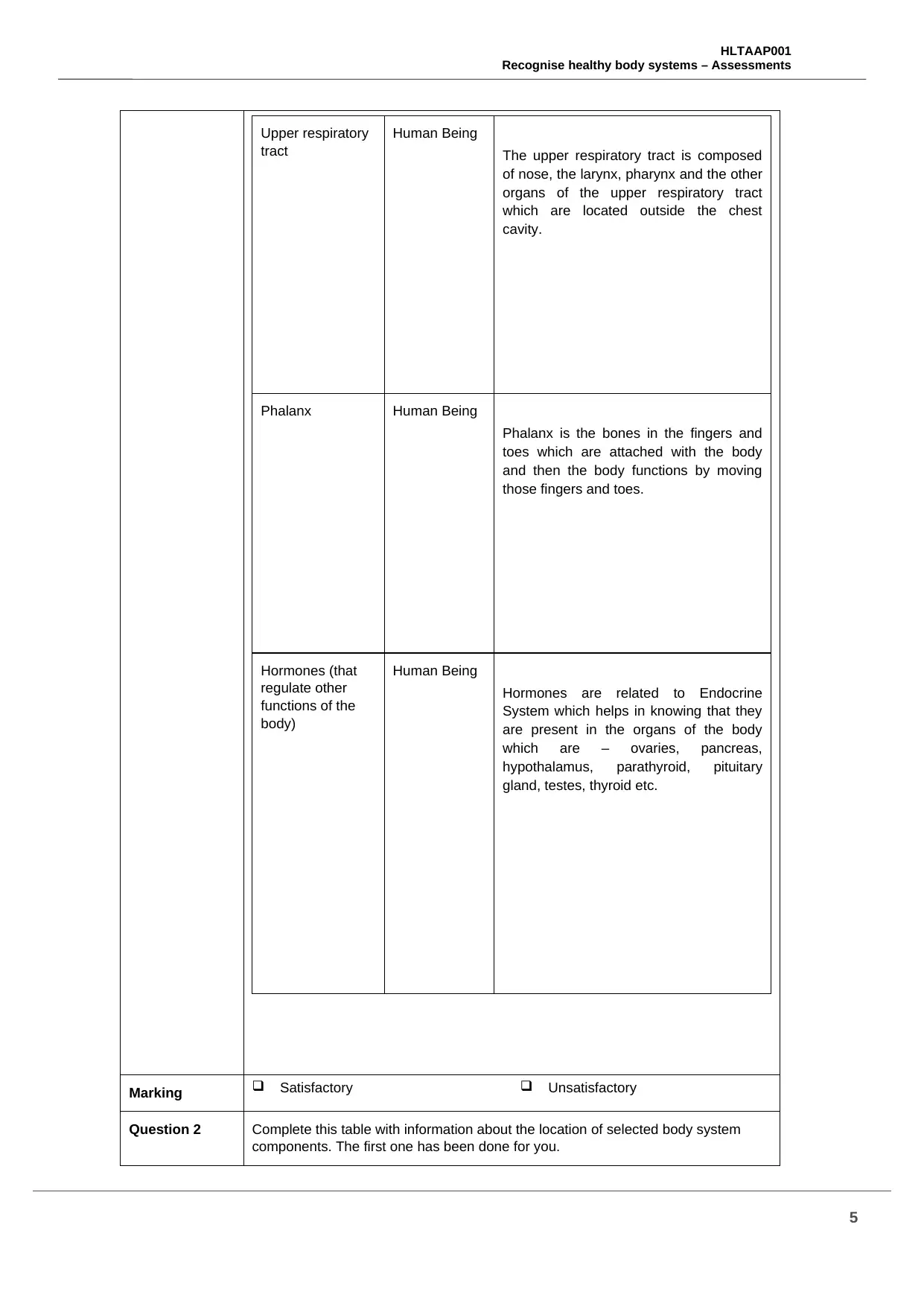
HLTAAP001
Recognise healthy body systems – Assessments
Upper respiratory
tract
Human Being
The upper respiratory tract is composed
of nose, the larynx, pharynx and the other
organs of the upper respiratory tract
which are located outside the chest
cavity.
Phalanx Human Being
Phalanx is the bones in the fingers and
toes which are attached with the body
and then the body functions by moving
those fingers and toes.
Hormones (that
regulate other
functions of the
body)
Human Being
Hormones are related to Endocrine
System which helps in knowing that they
are present in the organs of the body
which are – ovaries, pancreas,
hypothalamus, parathyroid, pituitary
gland, testes, thyroid etc.
Marking q Satisfactory q Unsatisfactory
Question 2 Complete this table with information about the location of selected body system
components. The first one has been done for you.
5
Recognise healthy body systems – Assessments
Upper respiratory
tract
Human Being
The upper respiratory tract is composed
of nose, the larynx, pharynx and the other
organs of the upper respiratory tract
which are located outside the chest
cavity.
Phalanx Human Being
Phalanx is the bones in the fingers and
toes which are attached with the body
and then the body functions by moving
those fingers and toes.
Hormones (that
regulate other
functions of the
body)
Human Being
Hormones are related to Endocrine
System which helps in knowing that they
are present in the organs of the body
which are – ovaries, pancreas,
hypothalamus, parathyroid, pituitary
gland, testes, thyroid etc.
Marking q Satisfactory q Unsatisfactory
Question 2 Complete this table with information about the location of selected body system
components. The first one has been done for you.
5
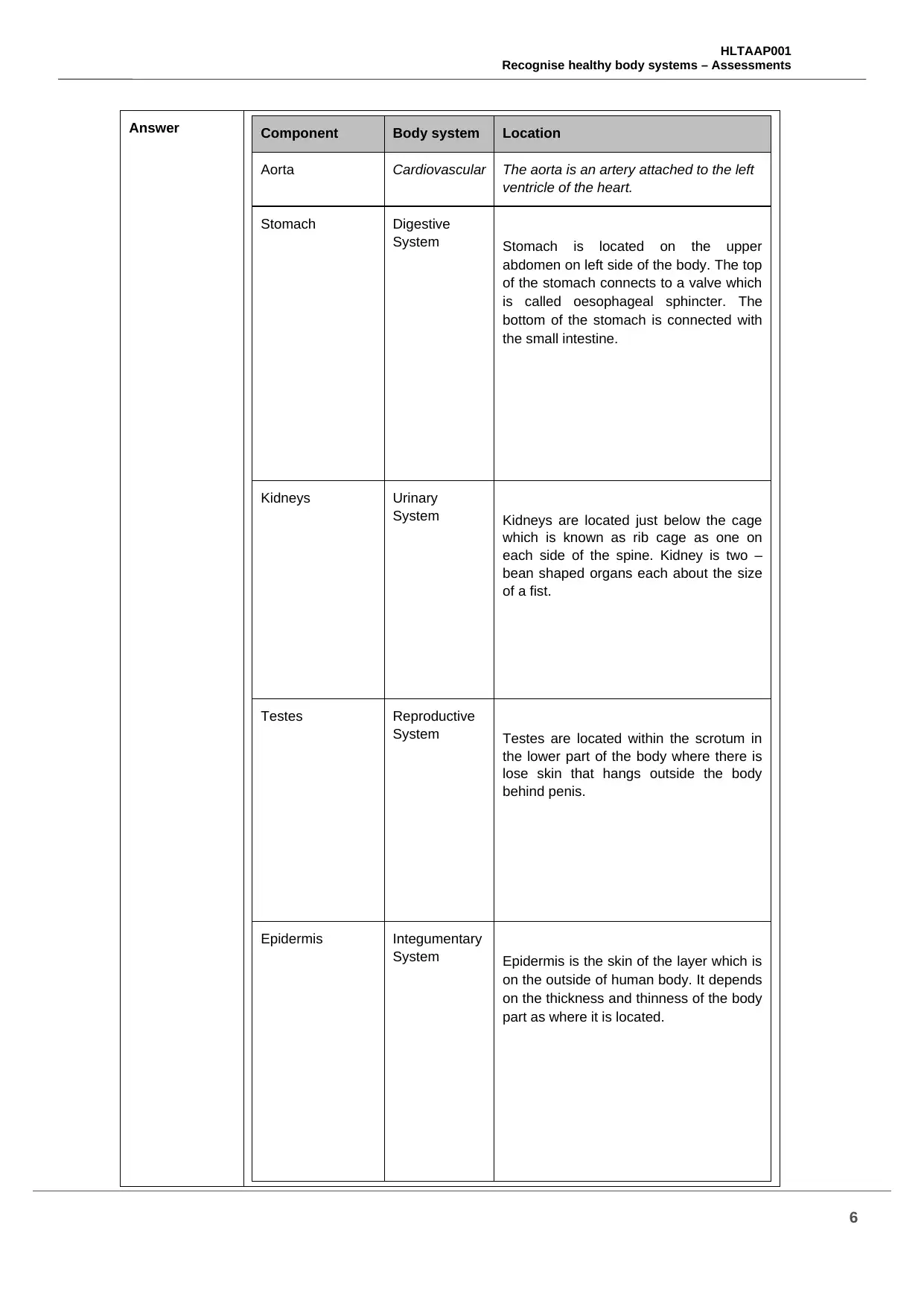
HLTAAP001
Recognise healthy body systems – Assessments
Answer Component Body system Location
Aorta Cardiovascular The aorta is an artery attached to the left
ventricle of the heart.
Stomach Digestive
System Stomach is located on the upper
abdomen on left side of the body. The top
of the stomach connects to a valve which
is called oesophageal sphincter. The
bottom of the stomach is connected with
the small intestine.
Kidneys Urinary
System Kidneys are located just below the cage
which is known as rib cage as one on
each side of the spine. Kidney is two –
bean shaped organs each about the size
of a fist.
Testes Reproductive
System Testes are located within the scrotum in
the lower part of the body where there is
lose skin that hangs outside the body
behind penis.
Epidermis Integumentary
System Epidermis is the skin of the layer which is
on the outside of human body. It depends
on the thickness and thinness of the body
part as where it is located.
6
Recognise healthy body systems – Assessments
Answer Component Body system Location
Aorta Cardiovascular The aorta is an artery attached to the left
ventricle of the heart.
Stomach Digestive
System Stomach is located on the upper
abdomen on left side of the body. The top
of the stomach connects to a valve which
is called oesophageal sphincter. The
bottom of the stomach is connected with
the small intestine.
Kidneys Urinary
System Kidneys are located just below the cage
which is known as rib cage as one on
each side of the spine. Kidney is two –
bean shaped organs each about the size
of a fist.
Testes Reproductive
System Testes are located within the scrotum in
the lower part of the body where there is
lose skin that hangs outside the body
behind penis.
Epidermis Integumentary
System Epidermis is the skin of the layer which is
on the outside of human body. It depends
on the thickness and thinness of the body
part as where it is located.
6
⊘ This is a preview!⊘
Do you want full access?
Subscribe today to unlock all pages.

Trusted by 1+ million students worldwide
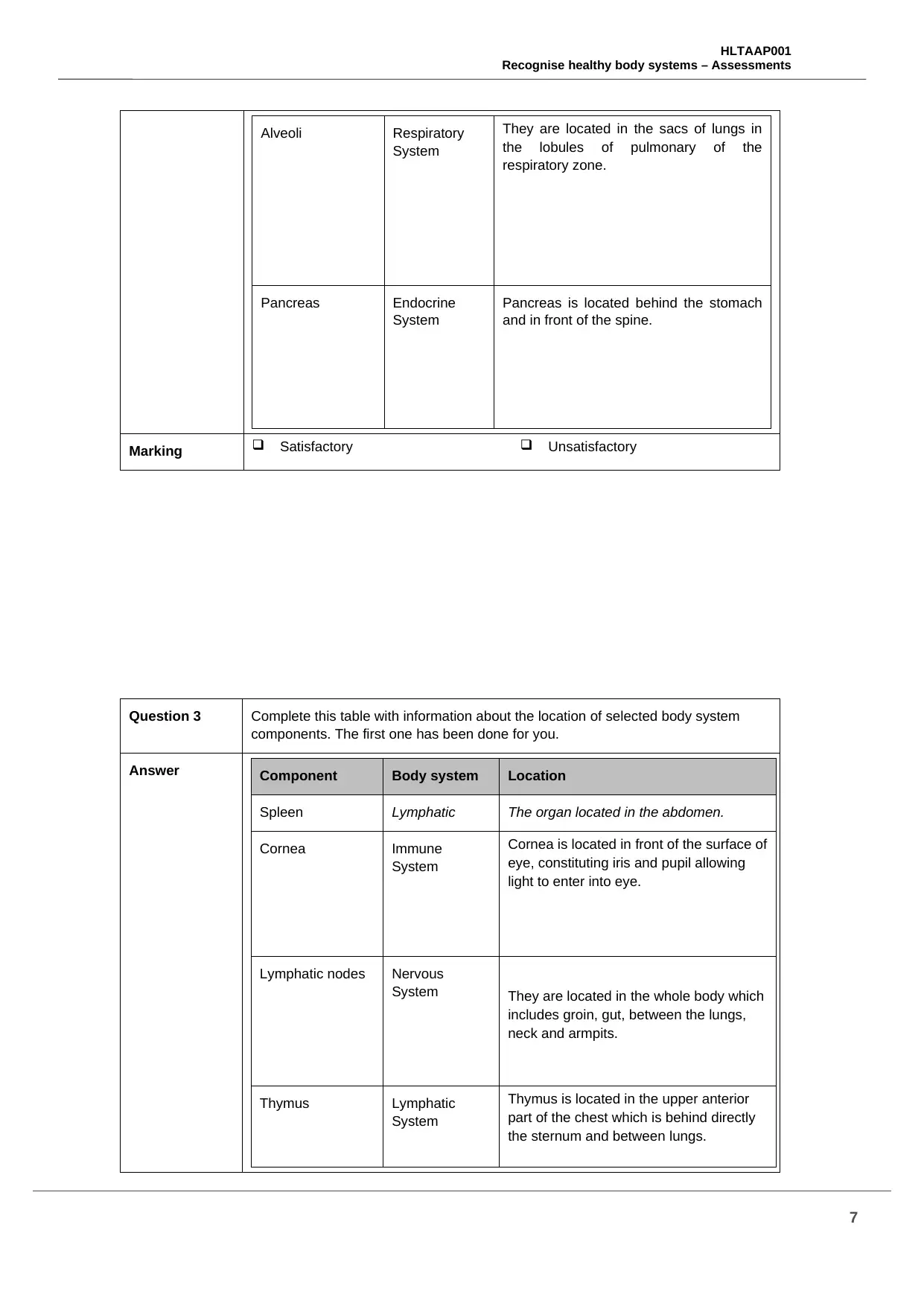
HLTAAP001
Recognise healthy body systems – Assessments
Alveoli Respiratory
System
They are located in the sacs of lungs in
the lobules of pulmonary of the
respiratory zone.
Pancreas Endocrine
System
Pancreas is located behind the stomach
and in front of the spine.
Marking q Satisfactory q Unsatisfactory
Question 3 Complete this table with information about the location of selected body system
components. The first one has been done for you.
Answer Component Body system Location
Spleen Lymphatic The organ located in the abdomen.
Cornea Immune
System
Cornea is located in front of the surface of
eye, constituting iris and pupil allowing
light to enter into eye.
Lymphatic nodes Nervous
System They are located in the whole body which
includes groin, gut, between the lungs,
neck and armpits.
Thymus Lymphatic
System
Thymus is located in the upper anterior
part of the chest which is behind directly
the sternum and between lungs.
7
Recognise healthy body systems – Assessments
Alveoli Respiratory
System
They are located in the sacs of lungs in
the lobules of pulmonary of the
respiratory zone.
Pancreas Endocrine
System
Pancreas is located behind the stomach
and in front of the spine.
Marking q Satisfactory q Unsatisfactory
Question 3 Complete this table with information about the location of selected body system
components. The first one has been done for you.
Answer Component Body system Location
Spleen Lymphatic The organ located in the abdomen.
Cornea Immune
System
Cornea is located in front of the surface of
eye, constituting iris and pupil allowing
light to enter into eye.
Lymphatic nodes Nervous
System They are located in the whole body which
includes groin, gut, between the lungs,
neck and armpits.
Thymus Lymphatic
System
Thymus is located in the upper anterior
part of the chest which is behind directly
the sternum and between lungs.
7
Paraphrase This Document
Need a fresh take? Get an instant paraphrase of this document with our AI Paraphraser
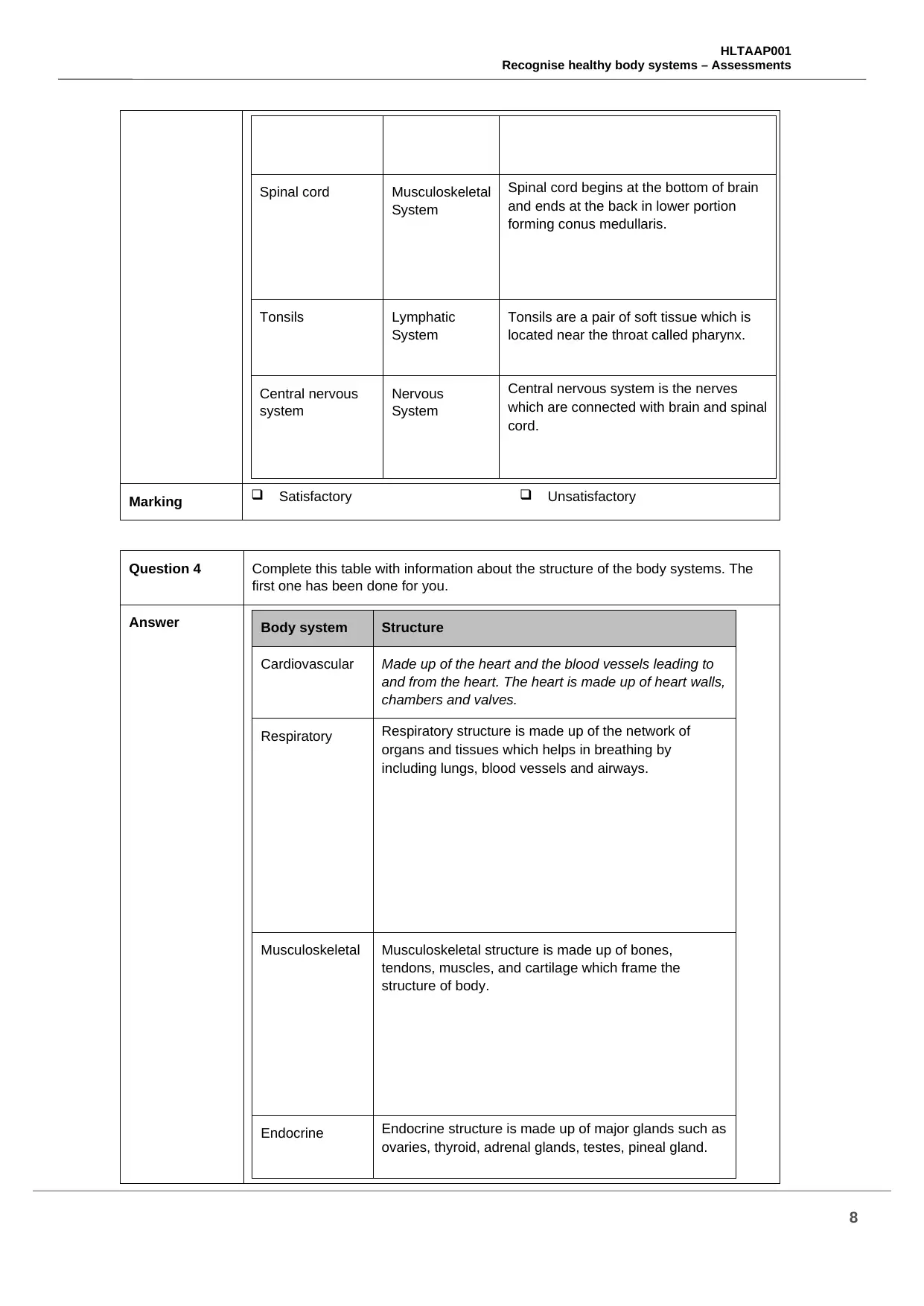
HLTAAP001
Recognise healthy body systems – Assessments
Spinal cord Musculoskeletal
System
Spinal cord begins at the bottom of brain
and ends at the back in lower portion
forming conus medullaris.
Tonsils Lymphatic
System
Tonsils are a pair of soft tissue which is
located near the throat called pharynx.
Central nervous
system
Nervous
System
Central nervous system is the nerves
which are connected with brain and spinal
cord.
Marking q Satisfactory q Unsatisfactory
Question 4 Complete this table with information about the structure of the body systems. The
first one has been done for you.
Answer Body system Structure
Cardiovascular Made up of the heart and the blood vessels leading to
and from the heart. The heart is made up of heart walls,
chambers and valves.
Respiratory Respiratory structure is made up of the network of
organs and tissues which helps in breathing by
including lungs, blood vessels and airways.
Musculoskeletal Musculoskeletal structure is made up of bones,
tendons, muscles, and cartilage which frame the
structure of body.
Endocrine Endocrine structure is made up of major glands such as
ovaries, thyroid, adrenal glands, testes, pineal gland.
8
Recognise healthy body systems – Assessments
Spinal cord Musculoskeletal
System
Spinal cord begins at the bottom of brain
and ends at the back in lower portion
forming conus medullaris.
Tonsils Lymphatic
System
Tonsils are a pair of soft tissue which is
located near the throat called pharynx.
Central nervous
system
Nervous
System
Central nervous system is the nerves
which are connected with brain and spinal
cord.
Marking q Satisfactory q Unsatisfactory
Question 4 Complete this table with information about the structure of the body systems. The
first one has been done for you.
Answer Body system Structure
Cardiovascular Made up of the heart and the blood vessels leading to
and from the heart. The heart is made up of heart walls,
chambers and valves.
Respiratory Respiratory structure is made up of the network of
organs and tissues which helps in breathing by
including lungs, blood vessels and airways.
Musculoskeletal Musculoskeletal structure is made up of bones,
tendons, muscles, and cartilage which frame the
structure of body.
Endocrine Endocrine structure is made up of major glands such as
ovaries, thyroid, adrenal glands, testes, pineal gland.
8
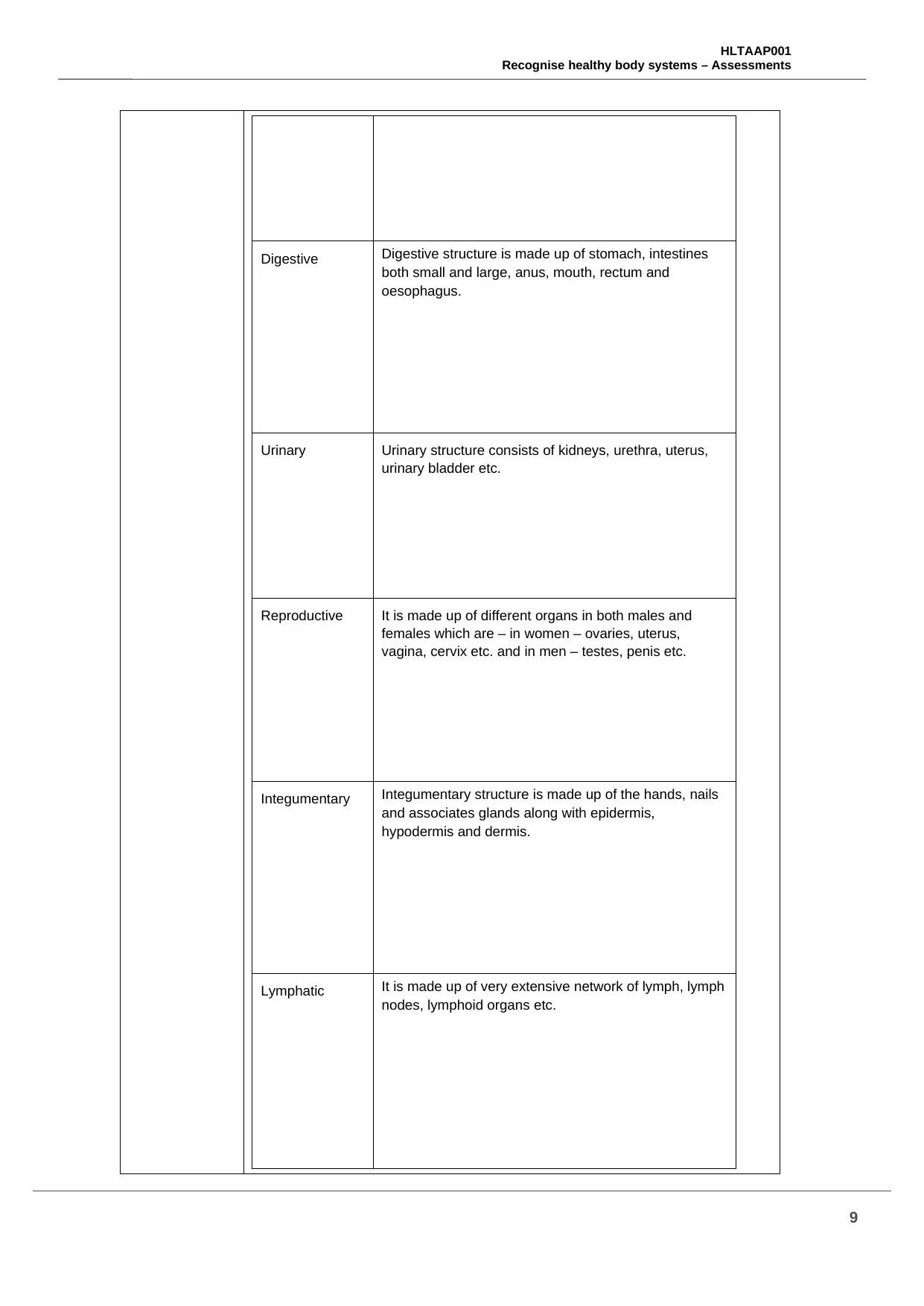
HLTAAP001
Recognise healthy body systems – Assessments
Digestive Digestive structure is made up of stomach, intestines
both small and large, anus, mouth, rectum and
oesophagus.
Urinary Urinary structure consists of kidneys, urethra, uterus,
urinary bladder etc.
Reproductive It is made up of different organs in both males and
females which are – in women – ovaries, uterus,
vagina, cervix etc. and in men – testes, penis etc.
Integumentary Integumentary structure is made up of the hands, nails
and associates glands along with epidermis,
hypodermis and dermis.
Lymphatic It is made up of very extensive network of lymph, lymph
nodes, lymphoid organs etc.
9
Recognise healthy body systems – Assessments
Digestive Digestive structure is made up of stomach, intestines
both small and large, anus, mouth, rectum and
oesophagus.
Urinary Urinary structure consists of kidneys, urethra, uterus,
urinary bladder etc.
Reproductive It is made up of different organs in both males and
females which are – in women – ovaries, uterus,
vagina, cervix etc. and in men – testes, penis etc.
Integumentary Integumentary structure is made up of the hands, nails
and associates glands along with epidermis,
hypodermis and dermis.
Lymphatic It is made up of very extensive network of lymph, lymph
nodes, lymphoid organs etc.
9
⊘ This is a preview!⊘
Do you want full access?
Subscribe today to unlock all pages.

Trusted by 1+ million students worldwide
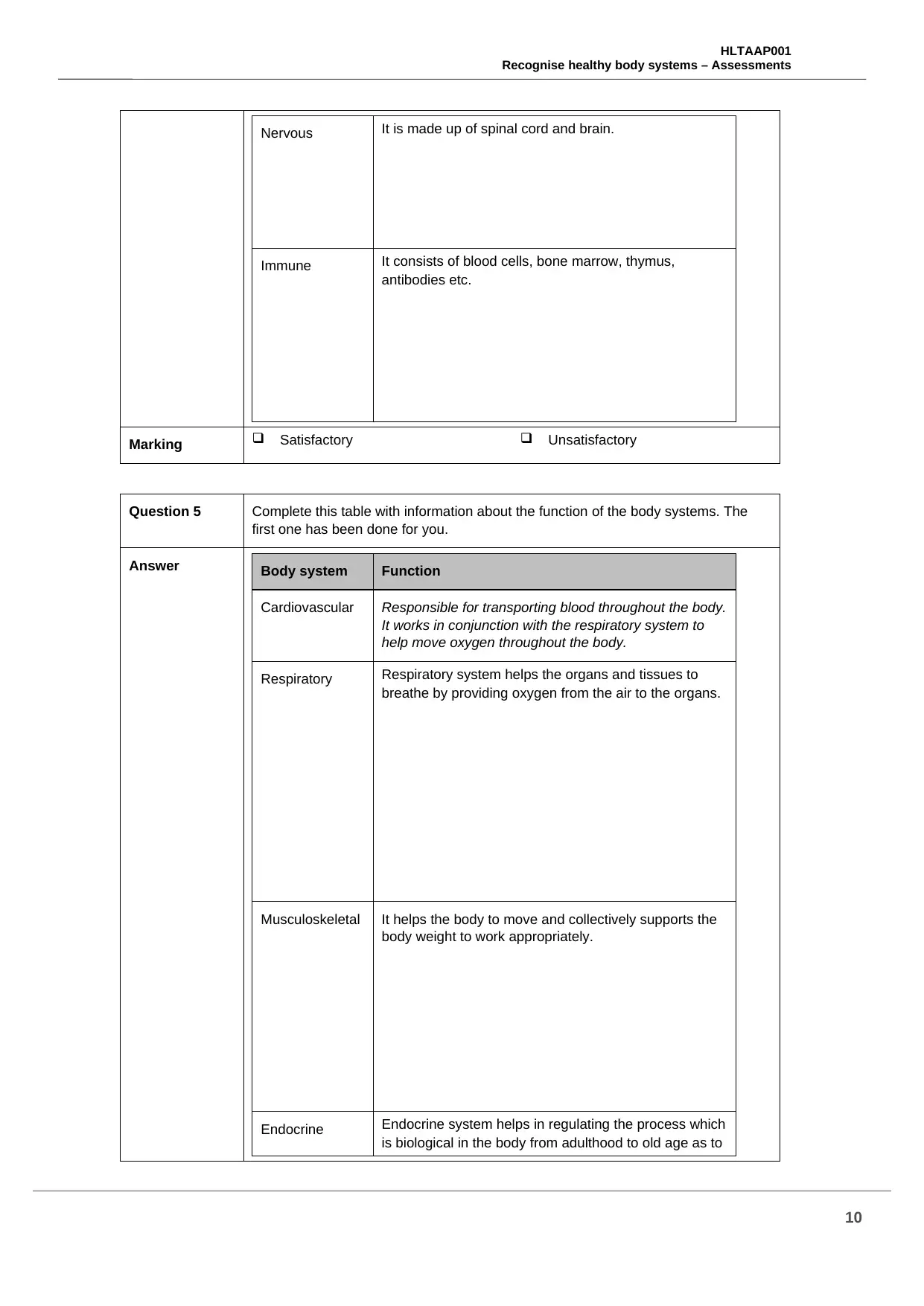
HLTAAP001
Recognise healthy body systems – Assessments
Nervous It is made up of spinal cord and brain.
Immune It consists of blood cells, bone marrow, thymus,
antibodies etc.
Marking q Satisfactory q Unsatisfactory
Question 5 Complete this table with information about the function of the body systems. The
first one has been done for you.
Answer Body system Function
Cardiovascular Responsible for transporting blood throughout the body.
It works in conjunction with the respiratory system to
help move oxygen throughout the body.
Respiratory Respiratory system helps the organs and tissues to
breathe by providing oxygen from the air to the organs.
Musculoskeletal It helps the body to move and collectively supports the
body weight to work appropriately.
Endocrine Endocrine system helps in regulating the process which
is biological in the body from adulthood to old age as to
10
Recognise healthy body systems – Assessments
Nervous It is made up of spinal cord and brain.
Immune It consists of blood cells, bone marrow, thymus,
antibodies etc.
Marking q Satisfactory q Unsatisfactory
Question 5 Complete this table with information about the function of the body systems. The
first one has been done for you.
Answer Body system Function
Cardiovascular Responsible for transporting blood throughout the body.
It works in conjunction with the respiratory system to
help move oxygen throughout the body.
Respiratory Respiratory system helps the organs and tissues to
breathe by providing oxygen from the air to the organs.
Musculoskeletal It helps the body to move and collectively supports the
body weight to work appropriately.
Endocrine Endocrine system helps in regulating the process which
is biological in the body from adulthood to old age as to
10
Paraphrase This Document
Need a fresh take? Get an instant paraphrase of this document with our AI Paraphraser
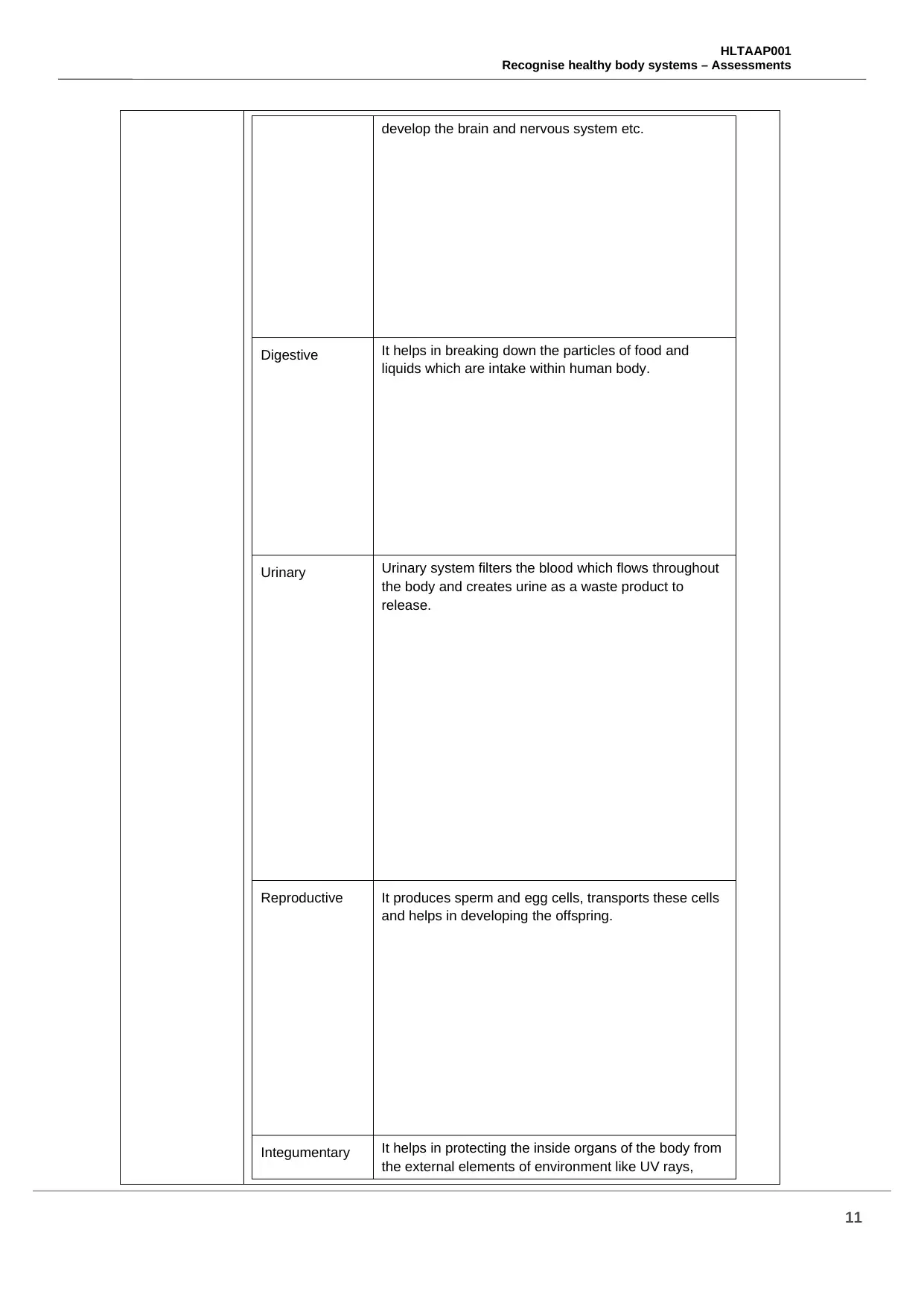
HLTAAP001
Recognise healthy body systems – Assessments
develop the brain and nervous system etc.
Digestive It helps in breaking down the particles of food and
liquids which are intake within human body.
Urinary Urinary system filters the blood which flows throughout
the body and creates urine as a waste product to
release.
Reproductive It produces sperm and egg cells, transports these cells
and helps in developing the offspring.
Integumentary It helps in protecting the inside organs of the body from
the external elements of environment like UV rays,
11
Recognise healthy body systems – Assessments
develop the brain and nervous system etc.
Digestive It helps in breaking down the particles of food and
liquids which are intake within human body.
Urinary Urinary system filters the blood which flows throughout
the body and creates urine as a waste product to
release.
Reproductive It produces sperm and egg cells, transports these cells
and helps in developing the offspring.
Integumentary It helps in protecting the inside organs of the body from
the external elements of environment like UV rays,
11
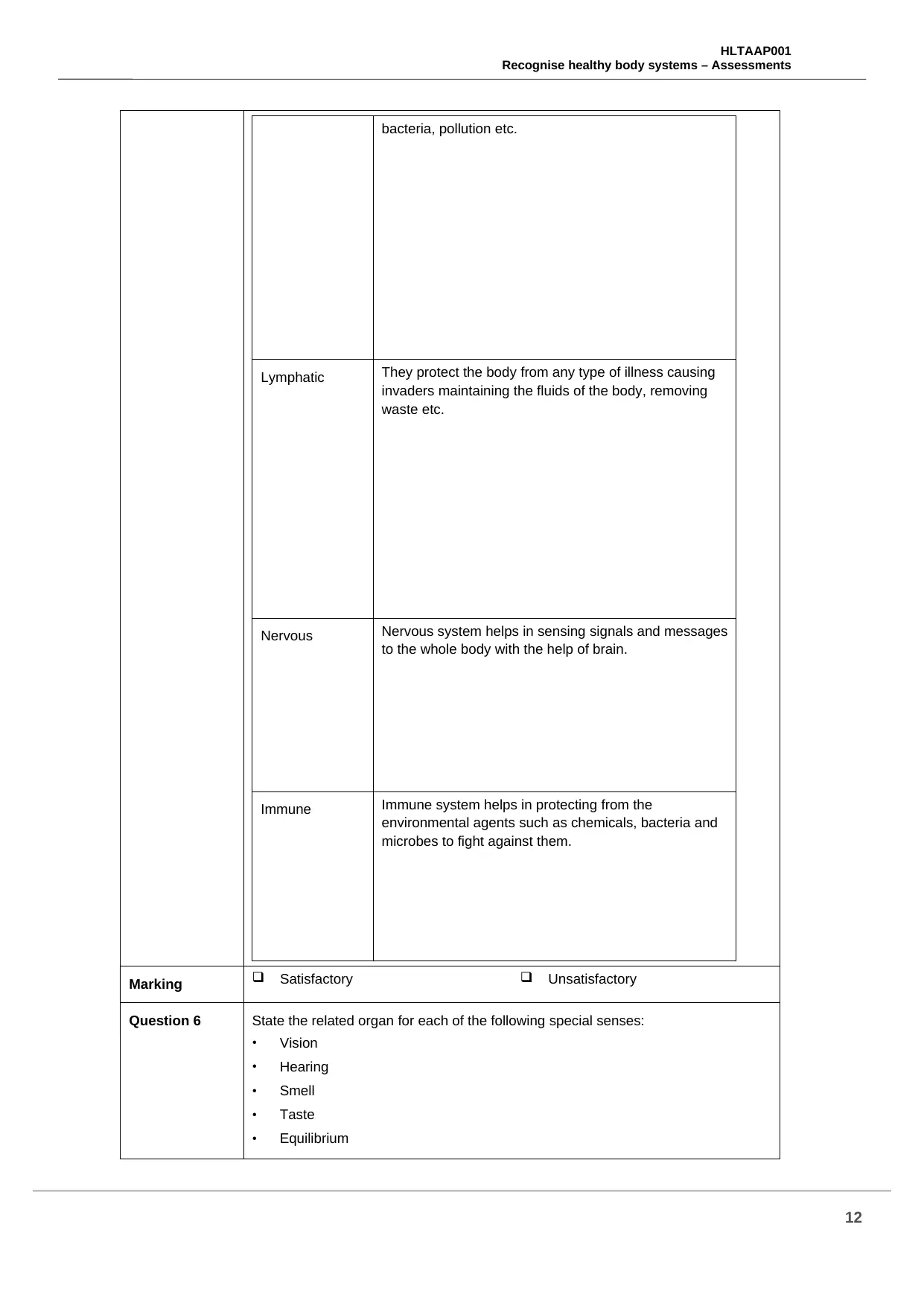
HLTAAP001
Recognise healthy body systems – Assessments
bacteria, pollution etc.
Lymphatic They protect the body from any type of illness causing
invaders maintaining the fluids of the body, removing
waste etc.
Nervous Nervous system helps in sensing signals and messages
to the whole body with the help of brain.
Immune Immune system helps in protecting from the
environmental agents such as chemicals, bacteria and
microbes to fight against them.
Marking q Satisfactory q Unsatisfactory
Question 6 State the related organ for each of the following special senses:
• Vision
• Hearing
• Smell
• Taste
• Equilibrium
12
Recognise healthy body systems – Assessments
bacteria, pollution etc.
Lymphatic They protect the body from any type of illness causing
invaders maintaining the fluids of the body, removing
waste etc.
Nervous Nervous system helps in sensing signals and messages
to the whole body with the help of brain.
Immune Immune system helps in protecting from the
environmental agents such as chemicals, bacteria and
microbes to fight against them.
Marking q Satisfactory q Unsatisfactory
Question 6 State the related organ for each of the following special senses:
• Vision
• Hearing
• Smell
• Taste
• Equilibrium
12
⊘ This is a preview!⊘
Do you want full access?
Subscribe today to unlock all pages.

Trusted by 1+ million students worldwide
1 out of 21
Your All-in-One AI-Powered Toolkit for Academic Success.
+13062052269
info@desklib.com
Available 24*7 on WhatsApp / Email
![[object Object]](/_next/static/media/star-bottom.7253800d.svg)
Unlock your academic potential
Copyright © 2020–2025 A2Z Services. All Rights Reserved. Developed and managed by ZUCOL.